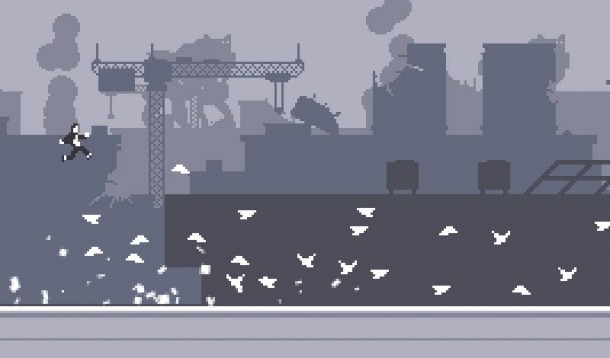Via Edge
-----

Passage
The Museum of Modern Art in New York (MoMA) last week announced that
it is bolstering its collection of work with 14 videogames, and plans to
acquire a further 26 over the next few years. And that’s just for
starters. The games will join the likes of Hector Guimard’s Paris Metro
entrances, the Rubik’s Cube, M&Ms and Apple’s first iPod in the
museum’s Architecture & Design department.
The move recognises the design achievements behind each creation, of
course, but despite MoMA’s savvy curatorial decision, the institution
risks becoming a catalyst for yet another wave of awkward ‘are games
art?’ blog posts. And it doesn’t exactly go out of its way to avoid that
particular quagmire in the official announcement.
“Are video games art? They sure are,” it begins, worryingly, before
switching to a more considered tack, “but they are also design, and a
design approach is what we chose for this new foray into this universe.
The games are selected as outstanding examples of interaction design — a
field that MoMA has already explored and collected extensively, and one
of the most important and oft-discussed expressions of contemporary
design creativity.”

Jason Rohrer
MoMA worked with scholars, digital conservation and legal experts,
historians and critics to come up with its criteria and final list of
games, and among the yardsticks the museum looked at for inclusion are
the visual quality and aesthetic experience of each game, the ways in
which the game manipulates or stimulates player behaviour, and even the
elegance of its code.
That initial list of 14 games makes for convincing reading, too:
Pac-Man, Tetris, Another World, Myst, SimCity 2000, Vib-Ribbon, The
Sims, Katamari Damacy, Eve Online, Dwarf Fortress, Portal, flOw, Passage
and Canabalt.
But the wishlist also extends to Spacewar!, a selection of Magnavox
Odyssey games, Pong, Snake, Space Invaders, Asteroids, Zork, Tempest,
Donkey Kong, Yars’ Revenge, M.U.L.E, Core War, Marble Madness, Super
Mario Bros, The Legend Of Zelda, NetHack, Street Fighter II, Chrono
Trigger, Super Mario 64, Grim Fandango, Animal Crossing, and, of course,
Minecraft.
Art, design or otherwise, MoMA’s focused collection is an uncommonly
informed and well-considered list. And their inclusion within MoMA’s
hallowed walls, and the recognition of their cultural and historical
relevance that is implied, is certainly a boon for videogames on the
whole. But reactions to the move have been mixed. The Guardian’s
Jonathan Jones posted a blog
last week titled Sorry MoMA, Videogames Are Not Art, in which he
suggests that exhibiting Pac-Man and Tetris alongside work by Picasso
and Van Gogh will mean “game over for any real understanding of art”.

Canabalt
“The worlds created by electronic games are more like playgrounds
where experience is created by the interaction between a player and a
programme,” he writes. “The player cannot claim to impose a personal
vision of life on the game, while the creator of the game has ceded that
responsibility. No one ‘owns’ the game, so there is no artist, and
therefore no work of art.”
While he clearly misunderstands the capacity of a game to manifest
the personal – and singular – vision of its creator, he nonetheless
raises valid fears that the creative motivations behind many videogames’
– predominantly commercially-driven entertainment – are incompatible
with those of serious art and that their inclusion in established
museums risks muddying its definition. But while many commentators have
fallen into the same trap of invoking comparisons with cubist and
impressionist painters, MoMA has drawn no such parallels.
“We have to keep in mind it’s the design collection that is
snapping up video games,” Passage creator Jason Rorher tells us when we
put the question to him. “This is the same collection that houses Lego,
teapots, and barstools. I’m happy with that, because I primarily think
of myself as a designer. But sadly, even the mightiest games in this
acquisition look silly when stood up next to serious works of art. I
mean what’s the artistic payload of, Passage? ‘You’re gonna die someday.’ You can’t find a sentiment that’s more artistically worn out than that.”

Adam Saltsman
But while he doesn’t see these games’ inclusion as a significant
landmark – in fact, he even raises concerns over bandwagon-hopping –
he’s still elated to have been included.
“I’m shocked to see my little game standing there next to landmarks
like Pac-Man, Tetris, Another World, and… all of them really, all the
way up to Canabalt,” he says. “The most pleasing aspect of it, for me,
is that something I have made will be preserved and maintained into the
future, after I croak. The ephemeral nature of digital-download video
games has always worried me. Heck, the Mac version of Passage has
already been broken by Apple’s updates, and it’s only been five years!”
Talking of Canabalt, creator Adam Saltsman echoes Rohrer’s sentiment:
“Obviously it is a pretty huge honour, but I think it’s also important
to note that these selections are part of the design wing of the museum,
so Tetris won’t exactly be right next to Dali or Picasso! That doesn’t
really diminish the excitement for me though. The MoMA is an incredible
institution, and to have my work selected for archival alongside obvious
masterpieces like Tetris is pretty overwhelming. “
MoMA’s not the only art institution with an interest in videogames,
of course. The Smithsonian American Art Museum ran an exhibition titled
The Art of Video Games earlier this year, while the Barbican has put its
weight behind all manner of events, including 2002?s The History,
Culture and Future of Computer Games, Ear Candy: Video Game Music, and
the touring Game On exhibition.

Eve Online
Chris Melissinos, who was one of the guest curators who put the
Smithsonian exhibition together and subsequently acted as an adviser to
MoMA as it selected its list, doesn’t think such interest is damaging to
art, or indeed a sign of out-of-step institutions jumping on the
bandwagon. It’s simply, he believes, a reaction to today’s culture.
“This decision indicates that videogames have become an important cultural, artistic form of expression in society,” he told the Independent.
“It could become one of the most important forms of artistic
expression. People who apply themselves to the craft view themselves as
[artists], because they absolutely are. This is an amalgam of many
traditional forms of art.”
Of the initial selection, Eve is arguably the most ambitious, and
potentially divisive, selection, but perhaps also the best placed to
challenge Jones’ predispositions on experiential ownership and creative
limitation. It is, after all, renowned for its vociferous,
self-governing player community.
“Eve’s been around for close to a decade, is still growing, and
through its lifetime has won several awards and achievements, but being
acquired into the permanent collection of a world leading contemporary
art and design museum is a tremendous honour for us,” Eve Online
creative director Torfi Frans Ólafsson tells us. “Eve is born out of a
strong ideology of player empowerment and sandbox openness, which
especially in our earlier days was often at the cost of accessibility
and mainstream appeal.

Torfi Frans Ólafsson
“Sitting up there along with industrial design like the original
iPod, and fancy, unergonomic lemon presses tells us that we were right
to stand by our convictions, so in that sense, it’s somewhat of a
vindication of our efforts.”
But how do you present an entire universe to an audience that is
likely to spend a few short minutes looking at each exhibit? Developer
CCP is turning to its many players for help.
“We’ve decided to capture a single day of Eve: Sunday the 9th of
December,” explains Ólafsson. “Through a variety of player made videos,
CCP videos, massive data analysis and info graphics.”
In presenting Eve in this way, CCP and the games players are
collaborating on a strong, coherent vision of the alternative reality
they’ve collectively helped to build, and more importantly, reinforcing
and redefining the notion of authorship. It doesn’t matter whether
you’re an apologist for videogames’ entitlement to the status of art, or
someone who appreciates the aesthetics of their design, the important
thing here is that their cultural importance is recognised. Sure, the
notion of a game exhibit that doesn’t include gameplay might stick in
the craw of some, but MoMA’s interest is clearly broader. Ólafsson isn’t
too worried, either.
“Even if we don’t fully succeed in making the 3.5 million people that
visit the MoMA every year visually grok the entire universe in those
few minutes they might spend checking Eve out, I can promise you it sure
will look pretty there on the wall.”
Personal Comments:
Passage is still available here, a game developed during Gamma256.
Canabalt is available here, while mobile versions are available for few bucks (android, iOS).






